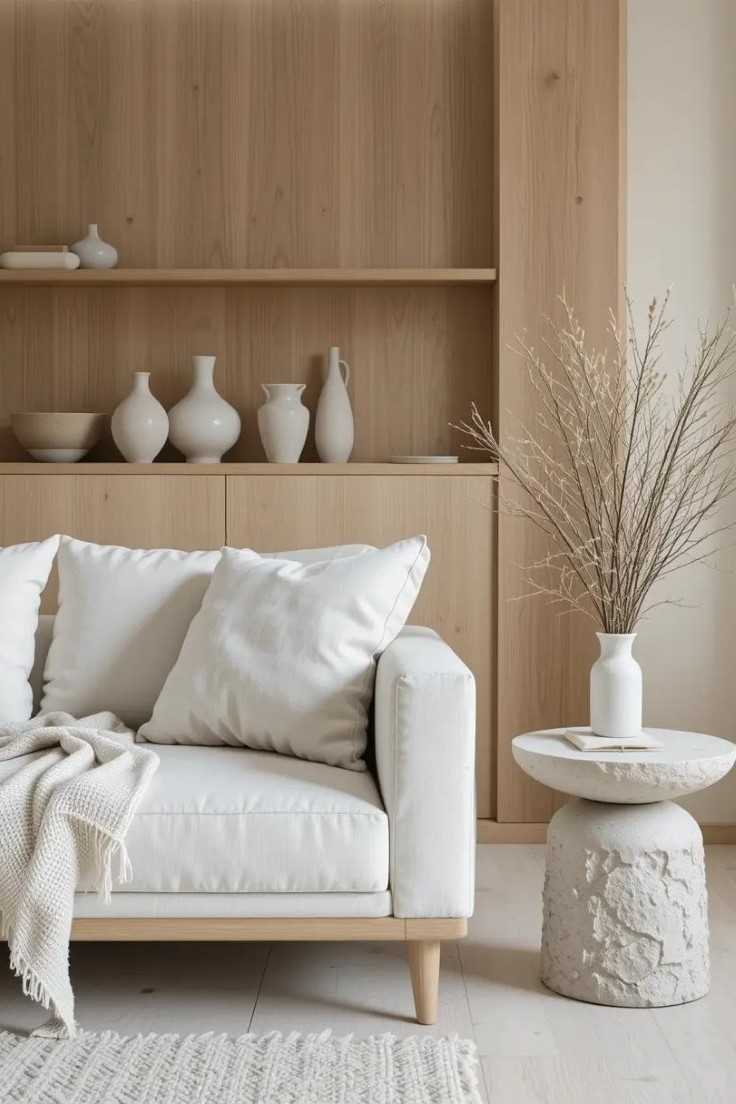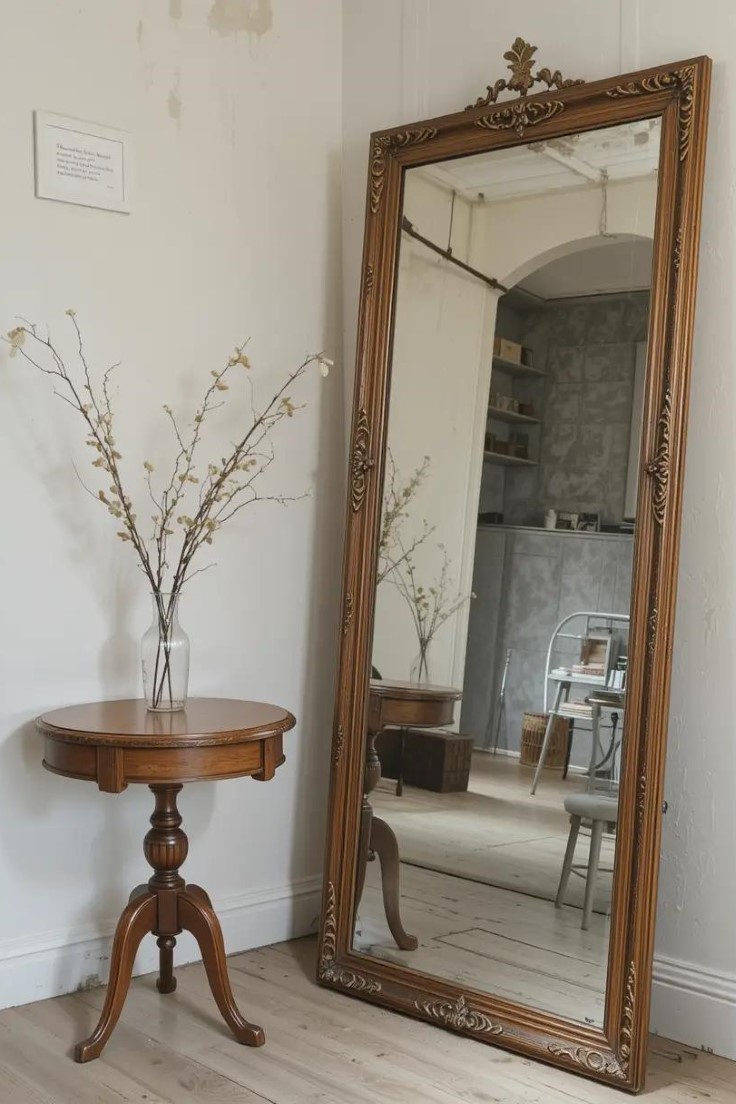This site contains affiliate links, view the disclosure for more information.
Transforming your Scandinavian living room goes beyond mere decoration – it’s about creating a thoughtful, functional environment that breathes simplicity and comfort. Originating from the Nordic regions, this Scandinavian living room design approach offers a perfect blend of minimalism, functionality, and warmth that can revolutionize your home’s interior.
Understanding the Essence of Scandinavian Living Room Design

Scandinavian living room ideas are rooted in a philosophy that celebrates simplicity, natural elements, and purposeful design. This approach emerged from the harsh Nordic climates, where people sought to create bright, welcoming spaces that counteract long, dark winters. The result is a Scandinavian living room design style that is both aesthetically pleasing and deeply practical.
1. Embrace a Neutral Color Palette

The cornerstone of a Scandinavian living room is a carefully curated color scheme. Think soft whites, muted grays, and gentle earth tones that create a sense of spaciousness and light.
These colors aren’t just a design choice – they’re a way to maximize natural light and create a sense of calm in your Scandinavian living room. Pro Tip: Layer different shades of neutrals to add depth and interest without overwhelming the space. Soft cream, light gray, and warm beige can work together beautifully in a Scandinavian living room, creating a harmonious and serene environment that feels both sophisticated and inviting.
2. Prioritize Natural Light and Lighting Design

Lighting plays a crucial role in Scandinavian living room design. Maximize natural light by keeping window treatments minimal or completely transparent. Use sheer, light curtains that allow sunlight to flood the space, creating an airy and open atmosphere.
When it comes to artificial lighting in your Scandinavian living room, the approach is equally thoughtful. Choose fixtures that are both functional and decorative, focusing on minimalist pendant lights with clean lines, sculptural floor lamps that double as statement pieces, and soft, warm-toned bulbs that create a gentle, inviting glow. The key is to create multiple light sources that can be layered to produce different moods and atmospheres throughout the day.
3. Incorporate Natural Materials
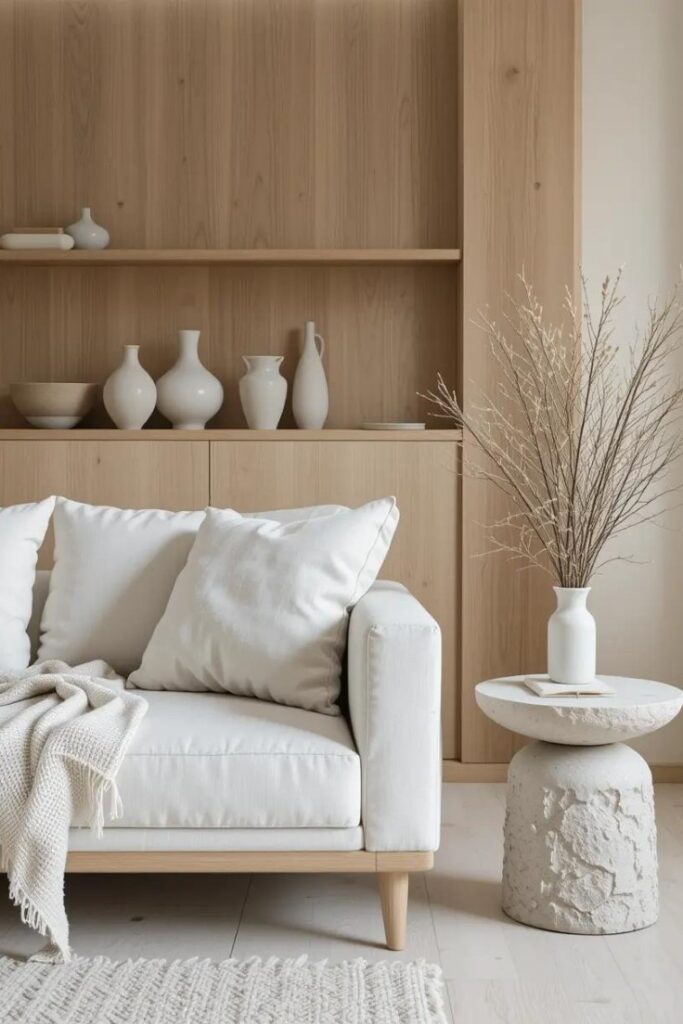
Wood is the heart and soul of Scandinavian living room design. Opt for light woods like birch, ash, or pine in your furniture and decor.
Consider incorporating wooden elements that tell a story in your living room – whether it’s a handcrafted coffee table, exposed wooden beams, or subtle wooden accents. Beyond wood, embrace a variety of natural materials that add texture and depth to your space. Think smooth natural stone elements that provide a subtle contrast, wool and linen textiles that invite touch and add warmth, and ceramic or clay decorative pieces that bring an organic feel to your living room.
Each material should be chosen with intention, creating a Scandinavian living room that feels connected to the natural world.
4. Minimalist Furniture with Purpose
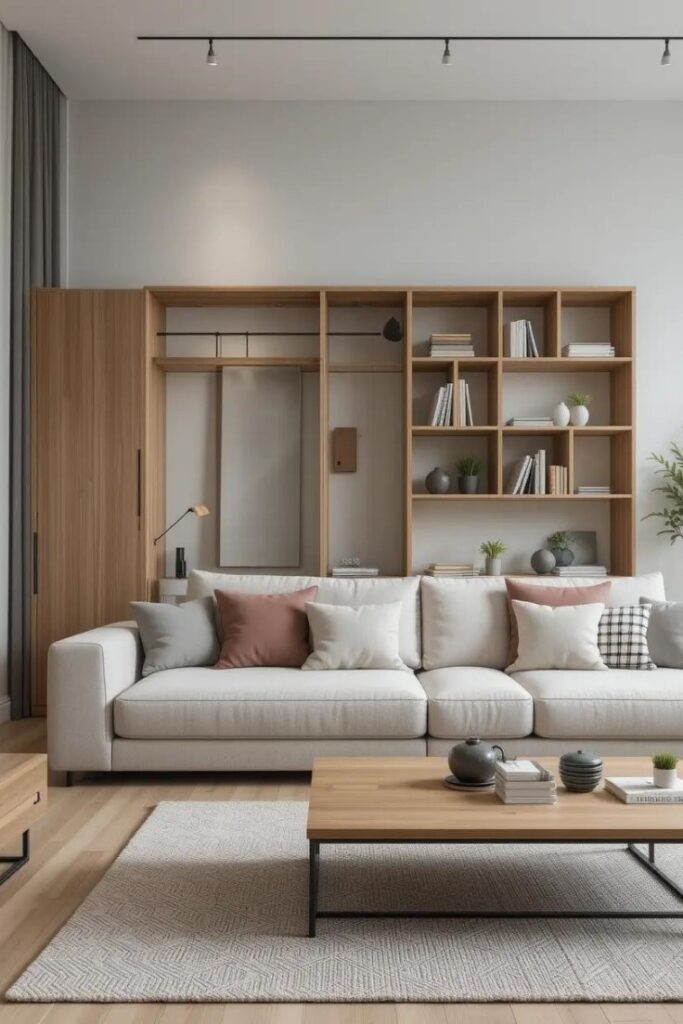
Scandinavian designs prioritizes furniture that is both beautiful and functional. Look for pieces that embody clean, geometric lines and serve multiple purposes.
The ideal Scandinavian living room furniture has slim profiles and neutral color schemes, creating a sense of space and lightness. Each piece should be carefully selected to contribute to the overall aesthetic while providing practical value. Consider a sofa with built-in storage, a coffee table that can be extended or adjusted, or seating that can be easily rearranged.
The goal is to create a Scandinavian living room that feels uncluttered yet incredibly inviting, where every item has a clear purpose and contributes to the room’s overall functionality.
5. Layer Textures for Warmth and Comfort

Despite its minimalist approach, a Scandinavian living room should feel incredibly cozy. Achieve this by thoughtfully layering soft, inviting textures that add depth and warmth to the minimalist design.
Drape a chunky knit blanket over a sleek sofa, spread a plush sheepskin rug on a wooden floor, arrange linen cushions that invite relaxation, and add wool throws that beckon you to curl up and unwind. These textural elements add depth and warmth to your Scandinavian living room design, creating a space that feels both clean and incredibly comfortable.
The key is to balance the simplicity of the design with touches that make the space feel lived-in and welcoming.
6. Create a Functional and Flexible Layout
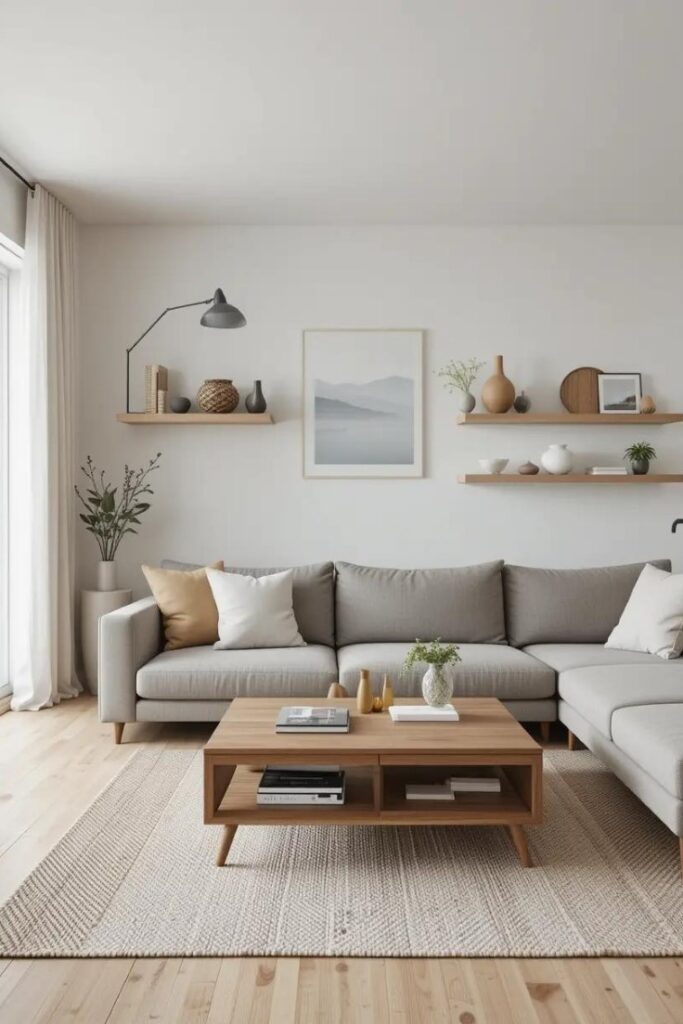
Scandinavian living room design is all about intelligent space planning. The layout should facilitate easy conversation, maximize natural light, ensure smooth movement, and create multi-functional areas.
Consider furniture that adapts to your needs – a modular sofa that can be reconfigured, an extendable coffee table that grows with your entertainment needs, storage ottomans that provide hidden space, and floating shelves that keep the floor area clean and open.
The goal is to create a Scandinavian living room that can effortlessly transition between different activities, from quiet reading to social gatherings, without feeling cluttered or constrained.
7. Bring Nature Indoors

Connect your interior with the natural world – a key principle of Scandinavian living room design. This goes beyond simply adding a few plants.
It’s about creating a holistic connection to the outdoors through carefully chosen natural accessories. Integrate indoor plants that bring life and freshness to the space, incorporate natural stone accessories that add subtle texture, include wooden decorative elements that tell a story, and embrace organic shapes and materials that echo the natural world.
This approach brings a sense of calm and connection to the outdoors, reflecting the Nordic appreciation for nature and creating a Scandinavian living room that feels both serene and alive.
8. Incorporate Sustainable and Eco-Friendly Elements

Scandinavian living room design is deeply rooted in a commitment to sustainability and environmental consciousness. This approach reflects a profound respect for the natural world and responsible living.
Choose furniture and decor pieces that tell a story of environmental stewardship. Look for items crafted from recycled materials, sustainably sourced wood, or pieces from local artisans who prioritize ecological production methods.
The true essence of a Scandinavian style lies in creating spaces that are both beautiful and mindful. Opt for textiles made from organic materials and furniture manufacturers who prioritize responsible production techniques.
9. Master the Art of Negative Space

Scandinavian living room design celebrates the power of negative space as a critical design element. This concept goes beyond minimalism – it’s about creating breathing room that allows each carefully selected piece to truly shine.
Allow your furniture to breathe by leaving ample space between pieces. Avoid filling every corner or wall, instead creating intentional gaps that provide visual rest and highlight the beauty of individual items.
Think of negative space as the quiet pause in a beautiful melody. Select fewer, more meaningful pieces that can stand out against the clean, open background.
For cozy corner ideas, check out 10 Cozy Corner Decor Ideas for a Warm and Inviting Look.
10. Create Zones of Functionality

Scandinavian living room design excels at creating multi-functional spaces that adapt to different needs. This approach recognizes that modern living requires flexibility and intelligent design.
Develop distinct zones within your living room that serve different purposes while maintaining a cohesive design aesthetic. Create a reading nook, design a workspace that can be tucked away, or establish a conversation area that invites interaction while maintaining an open feel.
The key is to design a living room that can seamlessly transition between different activities. Consider furniture that serves multiple purposes – a coffee table with hidden storage, a sofa that converts to a workspace, or ottomans that function as additional seating.
Maintaining Your Scandinavian-Inspired Living Room
Keeping your space true to Scandinavian-inspired living room ideas requires ongoing intentionality. Regular decluttering, mindful purchasing, and a commitment to functionality are key. Remember, it’s not about having less – it’s about making room for what truly matters.
Frequently Asked Questions About Scandinavian Living Room Design
Q1: How Do I Make My Living Room Look Scandinavian Without a Complete Renovation?
You don’t need to completely overhaul your space to embrace Scandinavian living room ideas. Start with small changes like introducing a neutral color palette, adding natural wood elements, and decluttering. Invest in a few key pieces like a minimalist coffee table, some soft textiles, and strategically placed indoor plants. Even simple swaps like light, sheer curtains and a wool throw can instantly bring Nordic-inspired charm to your living room.
Q2: Is Scandinavian Design Expensive to Implement?
Contrary to popular belief, Scandinavian design ideas can be budget-friendly. The philosophy is about simplicity and functionality, not necessarily about purchasing expensive designer pieces. Look for second-hand wooden furniture, DIY some decor elements, and focus on quality over quantity. Thrift stores, marketplace platforms, and budget-friendly furniture stores often have pieces that align perfectly with Scandinavian design principles.
Q3: How Do I Add Warmth to a Minimalist Scandinavian Living Room?
Warmth is actually a crucial element of Scandinavian design. Layer different textures through soft throws, chunky knit blankets, sheepskin rugs, and linen cushions. Use warm, soft lighting with multiple light sources like floor lamps and pendant lights. Natural materials like wood and wool inherently add warmth to the space. The key is creating a balance between minimalism and coziness.
Q4: Can Scandinavian Design Work in Small Living Rooms?
Absolutely! It is perfect for small spaces. The design philosophy emphasizes maximizing light, using multi-functional furniture, and maintaining a clutter-free environment. Choose furniture with clean lines and slim profiles, use light colors to create an illusion of space, and incorporate smart storage solutions. Floating shelves, wall-mounted furniture, and pieces with hidden storage can help you make the most of limited square footage.
Q5: How Do I Add Color to a Scandinavian Living Room?
While Scandinavian design favors neutral tones, it doesn’t mean complete color avoidance. Introduce subtle color through carefully chosen accessories like cushions, art pieces, or a single statement chair. Soft sage greens, muted blues, or warm terracotta can add depth without overwhelming the minimalist aesthetic. Remember, in Scandinavian design, less is more – so choose your color accents thoughtfully.
Q6: What’s the Difference Between Minimalist and Scandinavian Design?
While related, Scandinavian design is more than just minimalism. It emphasizes functionality, connection to nature, and creating comfortable spaces. Minimalist design focuses on reduction, while Scandinavian design focuses on purposeful selection. Scandinavian interiors feel lived-in and cozy, whereas minimalist spaces can sometimes feel sterile. The Nordic approach is about creating practical, beautiful spaces that enhance daily living.
Q7: How Do I Maintain a Scandinavian-Style Living Room?
Maintenance is about consistent mindfulness and intentional design. Regularly declutter, keep surfaces clean and clear, and be selective about what you bring into the space. Use storage solutions that keep items out of sight, and commit to a “less is more” approach. Clean lines, organized spaces, and a focus on functionality are key to maintaining the Scandinavian aesthetic.
Q8: Can I Mix Scandinavian Design with Other Styles?
Scandinavian living room ideas are surprisingly versatile. You can successfully blend Nordic design with elements of mid-century modern, industrial, or even bohemian styles. The key is to maintain the core principles of simplicity, functionality, and natural materials. Start with a Scandinavian base and carefully introduce complementary design elements.
Q9: What Lighting Works Best in a Scandinavian Living Room?
Lighting is crucial in Scandinavian design. Prioritize natural light by keeping windows unobstructed. For artificial lighting, choose fixtures with clean lines and soft, warm tones. Layer your lighting with a combination of floor lamps, pendant lights, and table lamps. Avoid harsh, direct lighting – instead, create a soft, diffused light that creates a warm and inviting atmosphere.
Q10: How Do I Choose Furniture for a Scandinavian-Style Living Room?
Focus on pieces that are both beautiful and functional. Look for furniture with clean lines, minimal ornamentation, and made from natural materials like wood. Choose lighter wood tones like birch or ash. Prioritize comfort and versatility – a sofa that looks great but is also comfortable for lounging, or a coffee table with hidden storage. The furniture should feel inviting and serve a clear purpose.

